Australia Rocks
We made it home from Australia (a day late and several hundred dollars poorer because of our missed flights)! I will save the conclusion of that story for another day. However, as today is “Boulder Sunday”, I will instead share my recent visit to Australia’s National Rock Garden in Canberra.
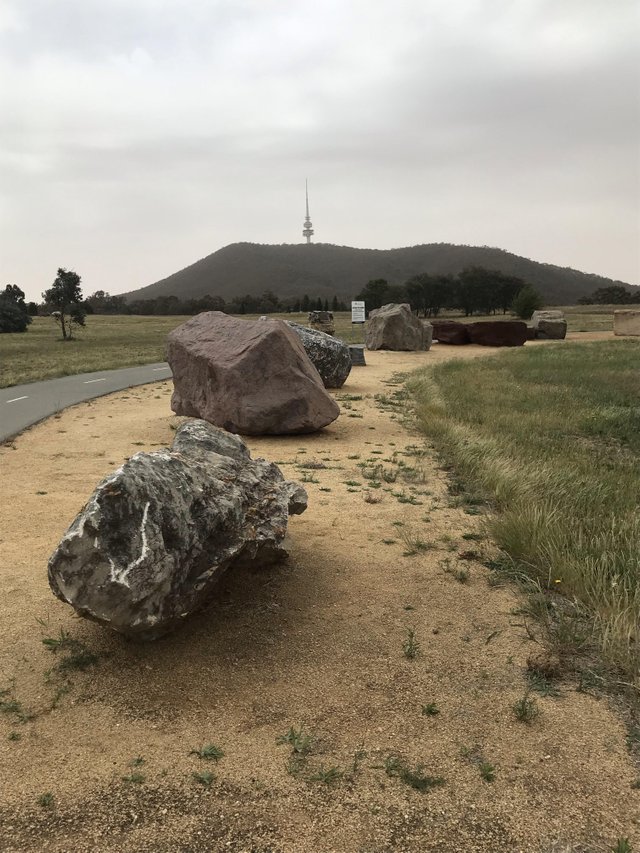
The National Rock Garden will celebrate Australia's rich geological heritage in a parkland setting within the national capital, with a permanent display, showcasing the diversity of the rocks, and minerals that contribute so significantly to the nation's landscapes, heritage and prosperity. Source
Thus far, the National Rock Garden is only a small sampling of the planned future site. The current display consists of one large boulder quarried from and representing each Australian state and territory. Each rock is presented in it’s natural form with a small polished area to show visitors the change that polishing brings to the rocks. A placard is embedded on each stone listing it’s material and significance.
Australia is known for its mineral wealth. Mineral mining and related industries are massive contributors to the nation’s economy. The mining industry creates both high paying and high skilled jobs (200,000 directly). source Additionally, the revenue from mining exports makes up 50% of the country’s export earnings. The demand for minerals in overseas markets (particularly China and India) protected Australia’s economy from much of the world wide downturn experienced in the early 2000’s. source
Geology has played a significant role in Australia’s history and continued success.
Moruya Tonalite - New South Wales
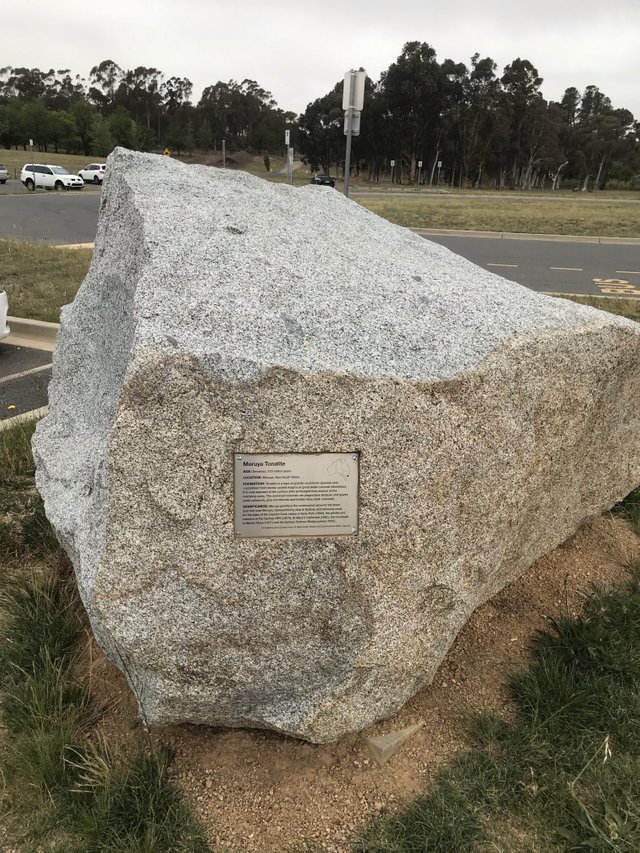
From the placard:
- Age: 379 million years
- Location: Moruya, NSW
- Formation: Tonalite is a type of granite - a plutonic igneous rock, crystallized from slowly cooled magma at a great depth. It is now exposed at the surface after prolonged slow erosion of the overlying rocks. The dominant minerals are plagioclase feldspar and quartz plus hornblende and biotite mica.
- Significance: Moruya granite is the commercial name for the stone quarried near Moruya, transported by ship to Sydney, and famously used for the base of the Captain Cook Statue in Hyde Park, the plinths and columns of the Sydney GPO (General Post Office), St. Mary’s Cathedral, the Cenotaph in Martin Place, and the Sydney Harbour Bridge pylons.
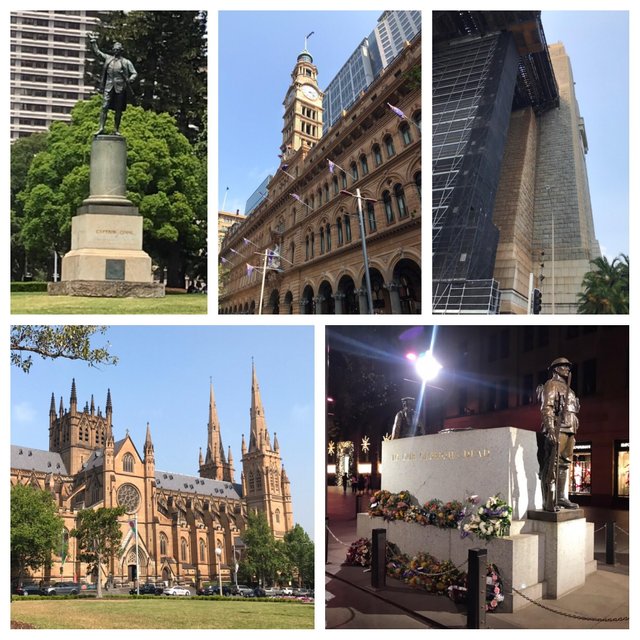
Tasmanian Dolerite - Tasmania
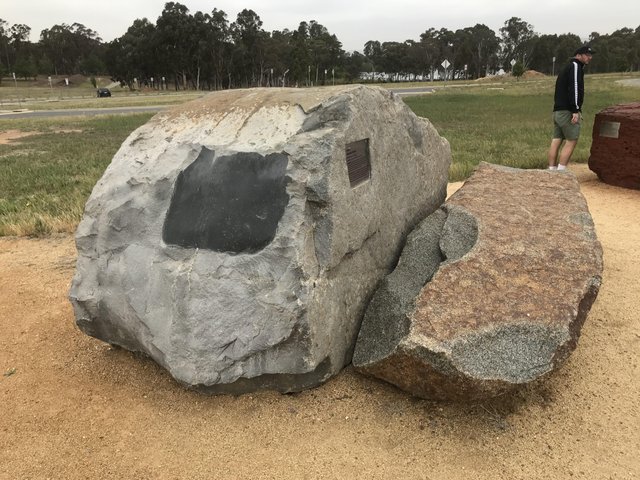
From the placard:
- Age: 175 million years
- Location: Leslie Vale south of Hobart, Tasmania
- Formation: During the breakup of Gondwana, dolerite magma was injected as dykes and sills (sheets) into thick sedimentary rocks, covering most of Tasmania. as they cooled and crystallized, regular vertical cracks propagated through the sills forming polygonal columns and the iconic “organ pipes” landscape above Hobart and elsewhere in Tasmania.
- Significance: Dolerite is unusually wide spread in Tasmania, and is referred to as “the rock that made Tasmania.” Altogether, the multiple sills comprise one of the world’s largest magma intrusions. The presence of the same Dolerite sills in Antarctica and South Africa contributed to our understanding of the breakup of the Gondwana supercontinent, of which Australia was the easterly part.
Brockman Iron Formation - Western Australia
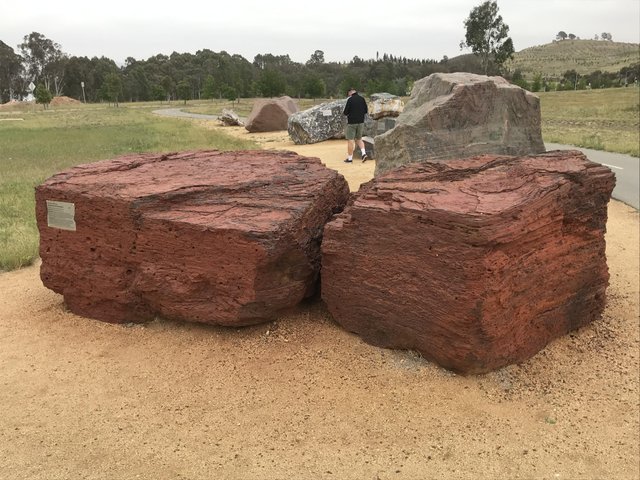
From the placard:
- Age: 2490 - 2450 million years
- Location: Hamersley Range, Pilbara region
- Formation: This banded iron formation (BIF) was deposited from dissolved ferrous iron in the early circulating waters of an early global ocean under a reducing atmosphere. The alternating bands show the marine environment see-sawing between oxygen rich and oxygen poor as microbial activity varied.
- Significance: It is the distinctive, spectacular precursor of the many globally significant Pilbara iron ore deposits and thus one of Australia’s most important rocks. Pilbara BIFs are the most exposed, least metamorphosed and least deformed BIFs on earth and contain the world’s largest concentration of iron, amounting to billions of tons of mineable ore.
Oorlano Metasomatite - South Australia
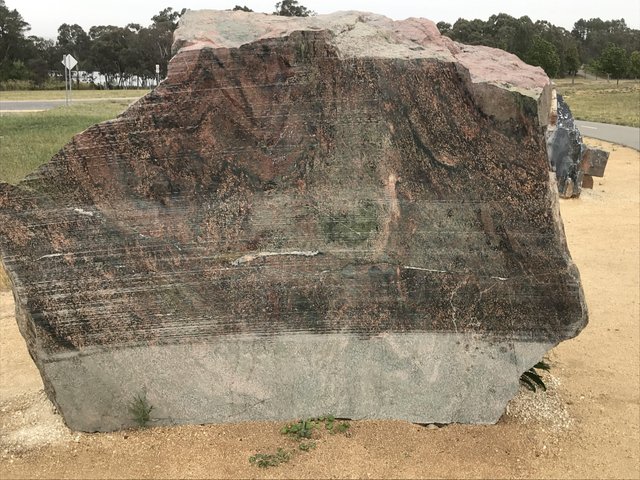
From the placard:
- Age: 1760 million - 1575 million years
- Location: Wallaroo, Yorke Peninsula
- Formation: The heat and fluid from granite intrusions formed this distinctive calc-silicate gneiss from calcareous sedimentary rocks. The colorful minerals include epidote, actinolite and diopside (green); feldspar and haematite (orange and red); and magnetite (black). Quartz-dolomite veins include pyrite and copper-bearing chalcopyrite.
- Significance: This spectacular and valuable “Harlequin Stone” is a widely exported decorative stone but it also expresses the geologic event that formed the giant Olympic Dam orebody and the historic Moonta and Wallaroo copper mines. Its geological history guides further mineral exploration.
Bendigo metasandstone and Ballarat quartz - Victoria
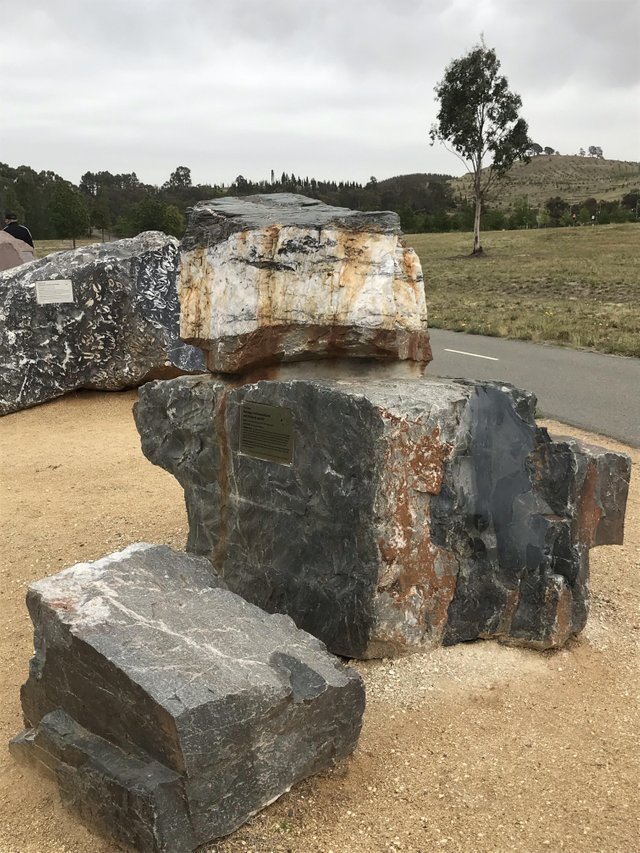
From the placard:
- Age: 480 - 440 million years
- Location: Bendigo and Ballarat, Victoria
- Formation: The lower rock was deposited as sand and mud in the ocean off eastern Australia in the Ordovician. In the early Silurian the sand and mud pile was folded, metamorphosed and injected with hot siliceous fluids to form white quartz veins in the upper rock, often with small amounts of metallic sulphides, and sometimes gold.
- Significance: These rocks are typical of the famous Bendigo and Ballarat Goldfields, which yielded vast riches during Victoria’s gold rushes of the 19th and 20th centuries.
Chinaman Creek Limestone - Queensland
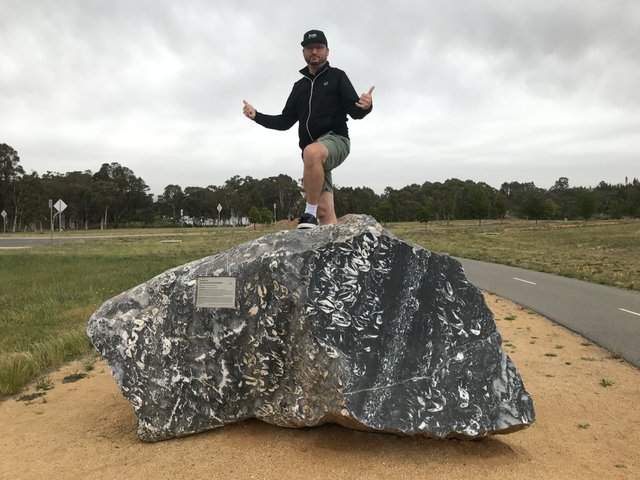
From the placard:
- Age: 390 - 400 million years
- Location: 220km west of Townsville, Queensland
- Formation: This limestone was formed from calcareous mud that accumulated in a tropical, shallow marine environment on the east Australian continental margin. It contains abundant fossil bivalves, corals, sponges and brachiopods, including shells of giant megalodont clams, many of which are preserved in their upright growth position.
- Significance: This abundantly fossilferous limestone can be regarded as a Devonian precursor to the Great Barrier Reef, Queensland’s most iconic natural feature. A spectacular decorative stone, it is being exported around the world. Other Devonian limestone is being used in the manufacture of cement.
Mt. Goyder Syenite - Northern Territory
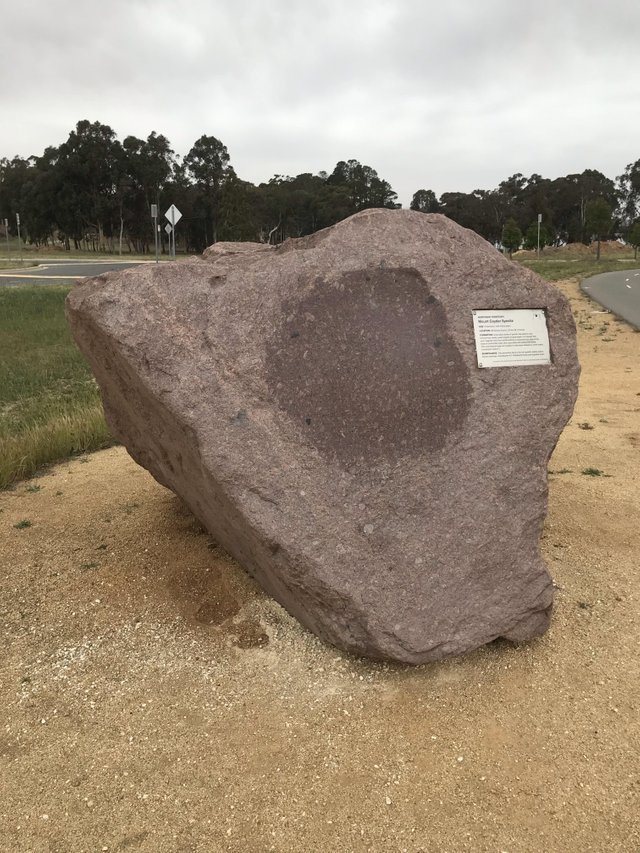
From the placard:
- Age: 1825 million years.
- Location: Mt. Bundey Quarry, 120km southeast of Darwin, Northern Territory.
- Formation: A low silica variety of granite, the plutonic rock formed from slowly cooled magma at great depth. It is thought that such magmas arise from partial melting of potassium-rich rocks at the base of the continental crust, often associated with subduction zones. This rock features large red crystals of orthoclase feldspar in a finer matrix.
- Significance: This decorative stone is the red “granite” widely used in Darwin buildings including the Northern Territory Parliament House and Supreme Court.
Canberra Limestone - Australian Capital Territory
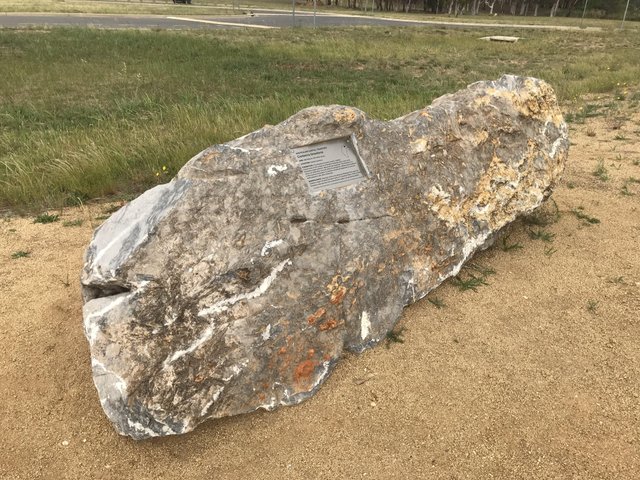
From the placard:
- Age: 430 million years
- Location: Central Canberra, Australian Capital Territory
- Formation: This limestone formed in warm, shallow, tropical seas on the continental margin of Australia, then apart of the Gondwana supercontinent. Marine life was abundant. The limestone is a minor, but distinctive rock unit within the sandstone, siltstone and mudstone of the Canberra Formation. It contains occasional fragments of coral and shell washed in with other sediments.
- Significance: Outcrops of this rock along the Molongolo River gave the area its early European name of “Limestone Plains”. Most of these limestone outcrops are now covered by Lake Burley Griffin.

We visited this garden mostly as a joke. It is essentially just a few rocks in the middle of a field with a parking lot attached. However, the information on each rock ended up being pretty interesting. The Geological Society of Australia is also raising funding for a future expansion of the garden. It is their vision that:
The National Rock Garden will be a tribute to this (Australia’) geological legacy, displaying rock specimens from across the continent in a single location in the nation’s capital city, Canberra. The National Rock Garden will be a world-class educational and tourist destination for all Australians as well as for international visitors. There will be more than one hundred spectacular rock specimens on display, carefully chosen to tell interesting stories about Australia’s geological heritage. source
Amazing! I never thought about how old the boulders are before.
I took maybe three geology classes in college (university). They were really fascinating. Once we got into the science bit and molecular structure of the rocks I got bored and new geology wasn’t my thing, but I loved the history of the rocks. So much time represented in each stone! 😍
Very cool. Where else could you store specimens that large? lol
Definitely not under glass in some museum. How confused will future geologist be to find these very out of place rocks all together in one spot! 😂🤣
True. Chances are the signs won't survive. lol
This posts rocks!
And rolls! 😁
Congratulations, Your Post Has Been Added To The Steemit Worldmap!
Author link: http://steemitworldmap.com?author=dfinney
Post link: http://steemitworldmap.com?post=australia-rocks
Want to have your post on the map too?
Thanks for using eSteem!
Your post has been voted as a part of eSteem encouragement program. Keep up the good work! Install Android, iOS Mobile app or Windows, Mac, Linux Surfer app, if you haven't already!
Learn more: https://esteem.app
Join our discord: https://discord.gg/8eHupPq
Looks like a cracking trip thanks for sharing 💯🐒
Thank you for stopping by! Trip was good, but being away from work is always inherently good! 😂
Nothing like a tour of Australia's rocks huh? Still, it was Canberra so probably not much else to do.
I used to live in Canberra.... 😄
There is stuff to do... it is just different. Soooo different from the other Australian cities. Visiting for a couple days every few years is alright, but I sure do wish my in-laws lived almost anywhere else in Aus! 😄
Haha, Canberra gets a bad wrap huh! It's actually a nice little place...Just...Somewhat boring. I'll be heading over to visit the War Memorial later next year I think. I'm pretty keen for that, other than that...Well, the Mint maybe?
The War Memorial is really one of the best museums anywhere and the cafe there makes a tasty meat pie! 😂
The Australia Museum is good. Touring Parliament House can be interesting the first couple times. It is crazy to me how the city has expanded. So many new suburbs. I don’t know where all the people came from!
I went to the War Memorial as a kid 40 years ago and have heard it's awesome now. I love Aussie war history so will be good I'm sure - I love me a pie too!
The last time I went to Canberra was on business so I saw the inside of my hotel and conference rooms...Looking forward to exploring a little more.
175 million years, 430 million years, 1825 million years... whoa.. those numbers just is unthinkable for my little mind!!! And what an appropriate article for #bouldersunday! These are the oldest boulders... ever!!!
I love your face😍 and your smiling eyes😍, my dearest @dfinney!!! You have a beautiful smile😍😍
I am glad you are home.
Have a terrific week ahead, and take care 🥰🌺🤙
Thank you for the lovely compliments @silversaver888. One day my face will probably look like an old rock! 😂🤣
Hehehe, and we shall all when we reach 95! I've seen fabulous looking women at 85... and we hope that you and I have good genes enough to get us through our old age looking fantastic. For certain, your beautiful smile will never fade, @dfinney. What a great gift and blessing you have!!! Take care, my dear friend 🥰🌺🤙
You have been curated by @rem-steem on behalf of Inner Blocks: a community encouraging first hand content, with each individual living their best life, and being responsible for their own well being. #innerblocks Check it out at @innerblocks for the latest information and community updates, or to show your support via delegation.
Thank you @innerblocks and @rem-steem! 🤗 💕
A very diversified land, I had no idea...
Being on the ring of fire up here, you would think that you would see exhibits like this up here also...
Glad you guys got to rock out !!!🤗
Yeah you would think. Minus the GIANT rocks I am sure we have stuff like this at the Burke Museum or one of the St Helens, Rainier or Olympic National parks visitors centers. Maybe just with dioramas. 😄
I think I did see a diorama like this at the Mt.Rainier visitor center this summer.
Most of our "rocks " over on the West side are just covered with forests.
I read somewhere, that Leavenworth Wa was the result of three to four large islands colliding millions of years ago!
Have you ever been to dry falls in eastern wa? It is probably my favorite geologic Washington story. During the last ice age a glacier plugged a river in Montana. Formed a lake known as glacial lake Missoula. Every time the water from the river/lake finally reached the top of the glacier a huge food would occur. Biggest flood in known geologic history EVER. This happened over and over with the freeze and thaw of the glacier. The lake would form again and again and flood. The water would rush from Montana, over Idaho and Eastern WA. The flooding created the scab lands in eastern wa. It was so strong it removed all of the top layers of land and soil across the state. And some massive boulders were also deposited along the way. All of this water also created a waterfall. Today Dry Falls has no water. But during this on again off again flood, the falls that formed at the location were also the BIGGEST falls ever known to have existed!
Soooooo cool.
Very, very cool!!
I saw a PBS program on this year’s ago, this was massive in the geological history of the West!
Can you just picture this happing!!!😳